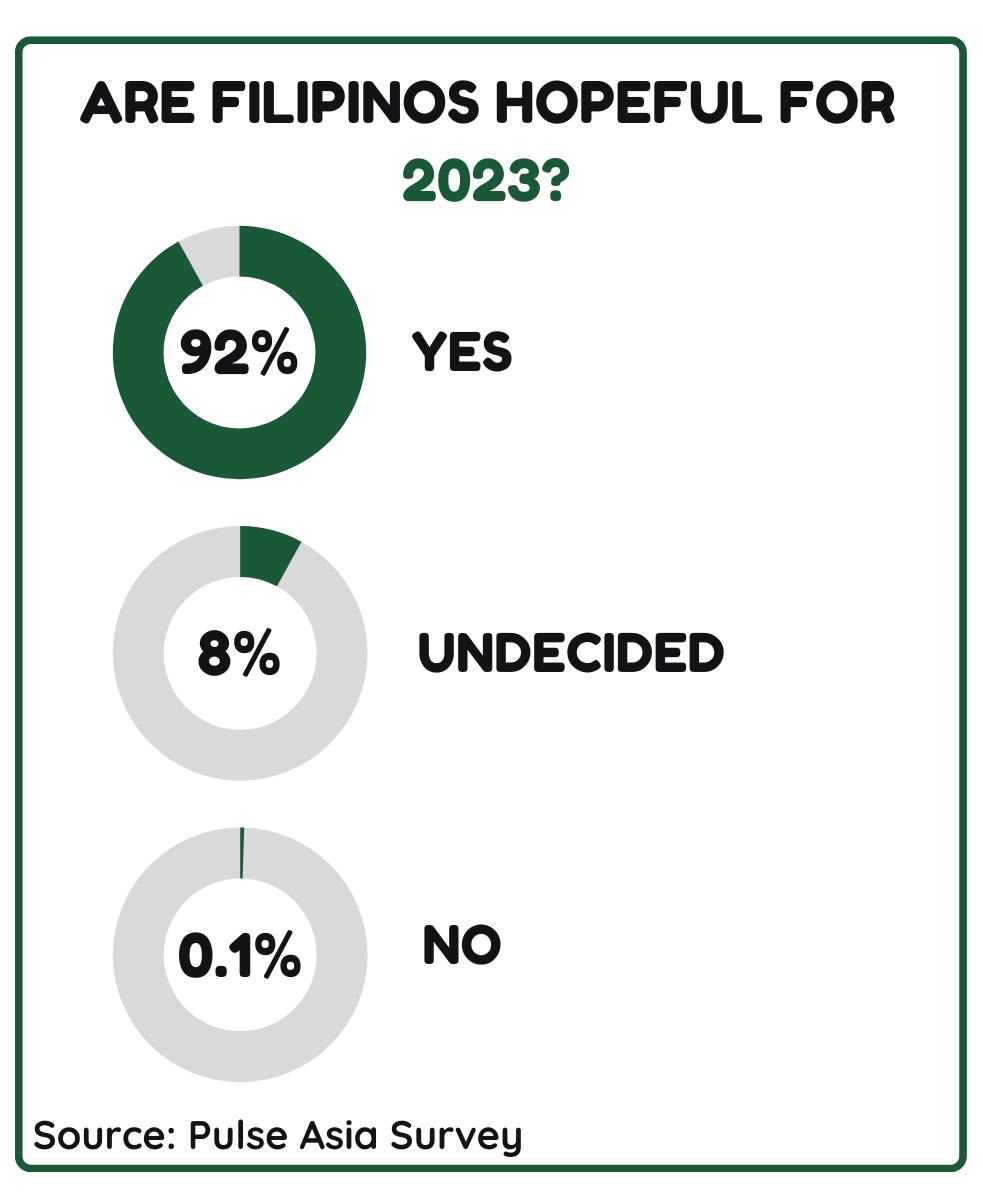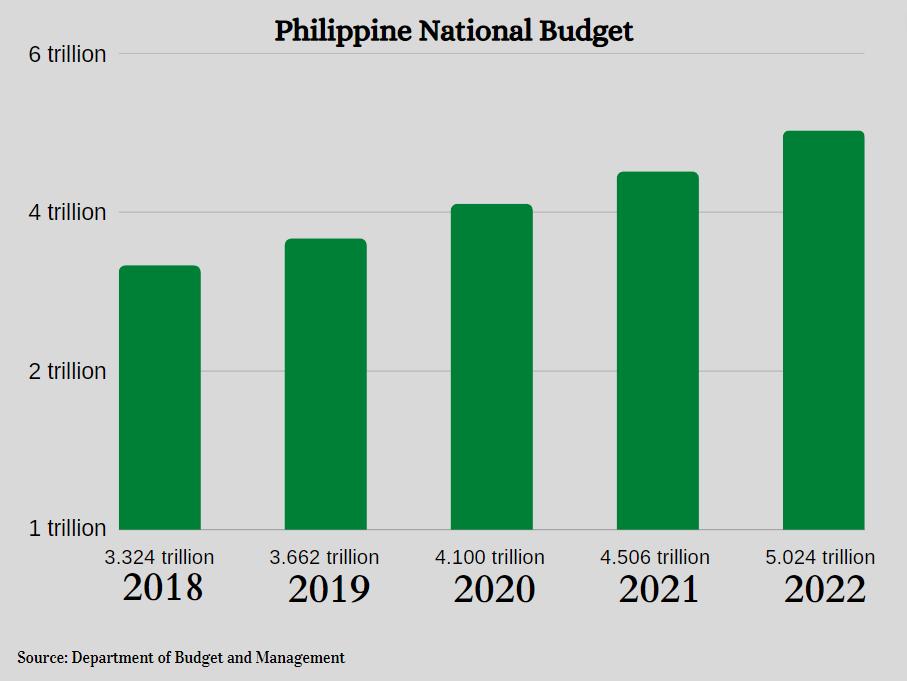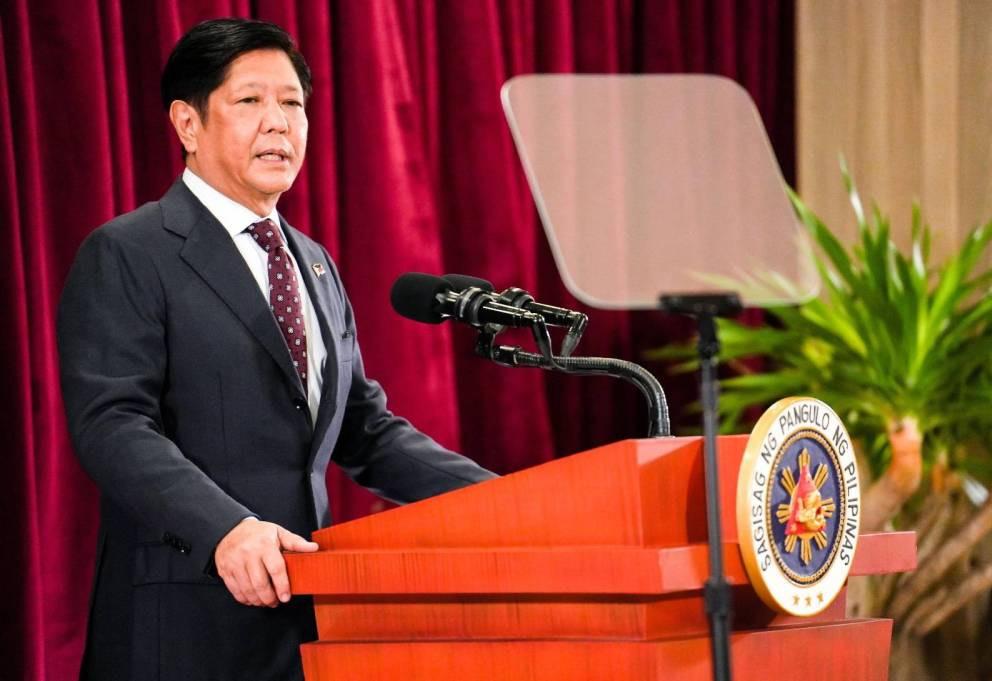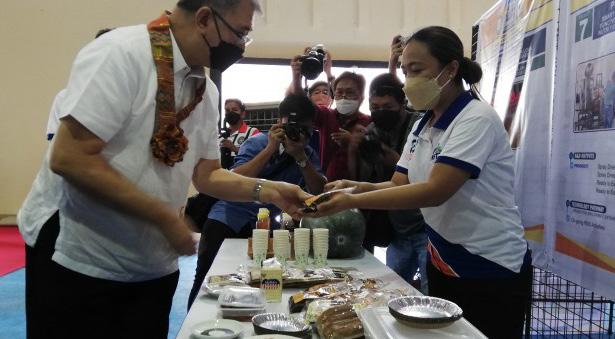Students compete in mystical extravaganza
JOSHUA NOCON
Members of the school community gathered to witness the culminating event and coronation night, held at the ASJ quadrangle, December 9.
With the theme “Spellbound Reverie: Myths, Mystics, and Magic,” thirty candidates took the stage and competed in the talent, costume, and question-and-answer portions.
At the end of the day, only two candidates from each grade level brought home the title of Mr. and Ms. ASJ 2023.

Trevor Vincent Medina and Alaina Laura Pedraza were crowned Mr. and Ms. ASJ in the preschool level,
When asked about the event, Mr. Richard Pineda, school principal, expressed his joy for the return of the pageant, and gratitude to those who made the event possible.
“I’d like to thank the people behind this activity: the parents, the organizers, the teachers, the support of the advisers,” Mr. Pineda said.
“And congratulations also to the winners,” he continued, “you deserve the crown and the prestige that have been given to you.”
Ms. Aileen Posadas had similar sentiments and also
“After two years of being under the pandemic—and we just started our face-to-face classes—I think tonight’s event is a very successful one,” Ms. Posadas expressed.

“This will not be possible, of course, without the support of our parents and the effort of our classroom advisers, and for this, we would like to thank our parents for overwhelming support throughout the years,” she added.

Apart from the contestants’ showcase of wits, talents, and beauty, the crowd got to watch an intermission number from the Lasallian Assembly of Student Leaders, the farewell walk of the titleholders of Ms. ASJ 2020, and a serenade for the candidates from Mr. John Mark Malangis and Mr. Arvie Bayan.
“I would like to thank everybody who helped me to get this award: my choreographer, the back-up dancers that we had, and my partner,” Villanueva said.
“To hold the title of Ms. ASJ, I think it’s a really big blessing because, to be honest, we are all winners in our own way,” Consulta stated, “and my message to my fellow students, supporters, and batchmates: just be yourself, and do what you love to do—follow your passion.”
The Search for Mr. and Ms. ASJ is an annual tradition for the school, and now that restrictions are loosened, it is anticipated to return every year. [R]
ASJ celebrates Christmas party

After two years of virtual Christmas parties, the students are finally back in school to celebrate Christmas with the ASJ community.
From singing, to dancing, to games and giving of gifts, the Christmas party for both grade school and high school students was held in campus, Thursday, December 15.
The grade school’s Christmas party was held from 2:00 PM to 6:00 PM, while the high school’s party, on the other hand,
began at 4:00 PM and ended at midnight.
After the grade school’s classroom Christmas party, the advent wreath was lit. This was followed by the Christmas intermission program wherein the presentation of adopt-a-child, the presentations of faculty and students, and the raffle took place.
At 8:00 PM, the high school night party began. During which, the “Vintage Rampage” fashion show took place, with the Grade 9 and Grade 12 winning first in their respective categories.
NIVERAAfterwards, the students were all on their own to enjoy the night.
Grade 11 student Kiel Legaspi said he’s thankful because almost half of his batch, who haven’t experienced the night party yet in the past, have now been able to participate in the event.
“Masaya, kasi halos kalahati ng batch namin hindi pa nakaka experience ng night party. So, thankful ako na na-experience nila kasi sobrang saya nito kahit nakakapagod,” Legaspi said.
Grade 12 student Mikylla Hayag also said she feels happy being able to bond with her classmates once again. However, she also feels sad since this is her batch’s last Christmas party in ASJ.
“Masaya naman siya because nagkaroon ulit ng bond ‘yung mga classmate ko, ‘yung Grade 12, pero at the same time, malungkot din kasi last year na namin ‘to dito,” Hayag stated.
The event, themed “vintage,” was facilitated by the Lasallian Assembly of Student Officers. [R]

Maharlika Investment Fund bill ‘hastily’ OK’d by House
The House of Representatives approved House Bill 6608, widely known as the Maharlika Investment Fund (MIF), which has been certified “urgent” by President Ferdinand Marcos Jr. himself, on Thursday, December 15.
The bill, on its third and final hearing, received 279 yes votes, 6 no votes, and 0 abstentions. The lawmakers who voted against the measure were
Gabriel Bordado (Camarines Sur, 3rd District), Raoul Manuel (Kabataan party-list), Edcel Lagman (Albay, 1st District), Mujiv Hataman (Basilan), France Castro (ACT Teachers party-list), and Arlene Brosas (Gabriela party-list).
The Senate must still pass a counterpart bill before the measure becomes a law.
President Ferdinand Marcos Jr., in a letter to House Speak-
er Martin Romualdez, claimed the fund would be strategic for strengthening investment activities in top performing government financial institutions and pump-prime economic growth and social development.
Finance Secretary Benjamin Diokno said the MIF should be an independent entity, managed and administered by the Maharlika Investment Corp. (MIC).
“The MIF and the MIC comply with the ‘Santiago’ Principles, which pertain to the set of generally accepted principles and practices voluntarily endorsed by the International Forum of SWF (sovereign wealth fund) members,” Diokno stated.
Albay Second District Rep. and Chair of the fund’s Technical Working Group Joey Salceda thanked the house for the consideration of the MIF, and said the “debate does not end here.”
“I will continue to study vi -
able models and frameworks for the MIF,” Salceda said. “I will continue to work with counterparts in the Senate to improve this measure or explain the proposal better.”
According to the measure, a total of ₱75 billion would be provided by the Landbank of the Philippines and the Development Bank of the Philippines (DPB). Additionally, the profits of the Bangko Sentral ng Pilipinas (BSP), which is estimated by the bill’s authors to be around ₱35 billion, will also be of use.
Originally, the bill envisioned a ₱275 billion fund, mostly sourced by the country’s Social Security System (SSS) and Government Service Insurance System (GSIS), however, due to public opposition, the idea was scrapped.
In total, it took only 17 days for the House to deliberate on the said bill, which received heavy criticism from lawmakers and the public alike. [R]
Marcos signs ₱5-trillion 2023 nat’l budget
President Ferdinand Marcos Jr. signed the 2023 General Appropriations Act (GAA) in a ceremony in Malacañang Palace, Friday, December 16.
The 2023 GAA, which allots ₱5.268 trillion for the country’s national budget this year, is 4.9% higher, or ₱244.4 billion higher than 2022’s national budget, which was ₱5.023 trillion.

Marcos, in his speech during the signing of the bill, emphasized the importance of the quick passage of the bill, saying it’s proof that the bill “is supported by our legislature.”

“And to see the rapidity of the passage is significant because it means that this budget, the roadmap that we have proposed from the Executive, is fully supported by our legislature. And that is very,
very important indeed,” Marcos said.
The President also claimed that the GAA will serve as the government’s tool in transforming the country’s economy and in helping the Philippines “move forward.”
“It is always very important that the GAA has been put together in consonance with all of the plans of the Executive. And that kind of coordination and that kind of synergy that we will gain from that is going to be an essential part of the way that we move forward,” Marcos stated.
House Speaker Martin Romualdez also stated that the newly signed law will assist the administration in improving the economy by sustaining growth, generating economic activities and jobs, and increasing
the income of Filipinos.
“It is the most important and potent tool the President, his economic team, and the entire government can use to accomplish the goals of the prosperity roadmap,” Romualdez claimed.
The signing of this year’s budget is the fastest and ear-


liest date that a national budget has been signed in history so far.
“As far as I can remember, the 2023 budget is one of the few spending bills signed into law in mid-December, way before the start of its implementation on New Year’s Day,” Romualdez added. [R]
ETHAN NIVERA ETHAN NIVERASIM card registration law officially takes effect
ETHAN NIVERAThe Subscriber Identity Module (SIM) Registration Act has officially taken effect on December 27.
On Monday, December 12, about two weeks before the implementation of the said act, the National Telecommunications Commission (NTC) released the Implementing Rules and Regulations (IRR) of the aforementioned act.
Under the IRR, Filipinos who use cellular services must comply with the rules and register their existing SIM cards. All SIM users have until June 27, 2023, 180 days from the effectivity of the law, to register their SIM cards before their cards face deactivation.


The database is managed by telecommunications company operators and/or public telecommunications entities (PTEs). Registration will be done through a secure platform or website provided by the telcos.
Subscribers will be asked for their full name, birth date, sex, official address, type of presented ID, and ID number. To register their SIM, a valid government-issued ID is required. Businesses, on the other hand, must provide their business name, address, and the full name of the business’ authorized signatory. Meanwhile, foreign nationals who want to register their SIM cards
in the Philippines must present their passport and address.
On October 10, 2022, President Ferdinand Marcos Jr. signed into law the Subscriber Identity Module (SIM) Registration Act, also known as Republic Act No. 11934, whose primary purpose is to provide accountability to all SIM card users and to improve cyber security in the country by making it “easier to track down cyber criminals.”
Subscribers encounter several problems during registration
The country’s major mobile network providers were flooded with waves of complaints as technical errors filled the first day of registration.
Errors such as glitches, crashes, and the unavailability of the registering portals left many mobile users unable to register.
“It is clear that both telecommunications companies (Smart and Globe) and the Department of Information and Communications Technology (DICT) are unprepared for this implementation,” the Junk Sim Registration Network said.
According to the DICT, the first two weeks of the SIM registration are mainly testing peri -
ods, therefore, technical issues are expected.

The DICT added that during the testing period, mobile network carriers should be able to assess and survey what needs to be improved to make the registration process smoother.
“SIM card law may not serve its purpose,” critics claim
Although the law is meant to better improve surveillance and aid in cyber security, groups and professionals have expressed their doubt toward this claim.
Cybersecurity policy analyst Mary Grace Mirandilla-Santos, the bill may do more harm than good.
“SIM registration has the potential to put the security, privacy, and welfare of citizens at risk. Experiences from other developing countries and the European Union show that SIM card registration may pose more risks than benefits to citizens,” Mirandilla-Santos said.
Data Privacy Lawyer Atty. Maria Cecilia Soria said she “isn’t that optimistic” about the said purpose of the law.
“At the end of the day, this just gives law enforcement a starting point. They will still have to identify the
perpetrators and build a good case to have the people convicted. It’s only when they see people arrested and convicted that there will be some type of deterrent, and as long as we don’t see that, I really am not optimistic that this law will be able to stop SMS scams and spams,” Soria said.
Asked if the Philippines really needed the SIM card registration law, Soria immediately answered “no”.
“As a lot of digital rights activists have been pointing out, the experience of other countries has shown that it does not really prevent scams and spams conducted over SMS. There was a country in Southeast Asia (Indonesia) whose SIM database was hacked. We are creating burdens all around, basically,” she stated.
“We have estimated 180 million subscribers, so how will we determine the scammers? In order to deter the scammers, we will need to burden 180 million people and require them to register, require telcos to build databases and to continually protect these databases,” she added.
Findings show that mandatory SIM card registration policies adopted by several countries including Canada and Ireland were “inefficient.” Mexico also had the said SIM card registration policy in 2009, but removed it after it was discovered to be “ineffective.”
GenTri youth attend 10th Youth Leaders Summit
Every year, the City Government of General Trias organizes a youth summit where young citizens from the various schools, universities. and youth organizations of General Trias get the chance to develop their leadership skills.
The summit held in the General Trias Cultural and Convention Center this December 19, 2022, officially marked the 10th edition of the project with the theme “Let’s Join Forces for Empowered Youth Leaders of GenTri.”
Over 900 youth leaders took part in the event, which was headed by Mayor Luis “Jon-Jon” Ferrer, Congressman Antonio “Ony” Ferrer, Vice Mayor Jonas Labuguen, and members of the Sangguniang Panlungsod and City Youth Development Office.
Starting off the discussions about leadership, four of the winners of Binibining GenTri 2022 walked on the stage to give their own messages and motivation to the audience, which was shortly followed by a question-and-answer session.
They comprised of 4th runner-up Argie Ereño, 3rd runner-up Trishia Lanuzo, 1st runner-up Leina Ann Arnes, and lastly, Binibining GenTri 2022, Atasha Reign Parani, who inspired the youth with her words, “I’m young, but I’m capable of so many things.”
This was followed by the introduction of author and motivational speaker Arun Gogna who focused on the importance of happy relationships.
He shared stories, experiences, and lessons about having happy relationships
with oneself, one’s family, friends, and God, highlighting how these relationships can affect someone’s outlook in life, especially the relationship with oneself. “The way you look at yourself is the way you live your life,” Gogna emphasized.
In the latter part of the event, Mayor Jon-Jon motivated the youth leaders to speak up for their needs and be the “voice of the youth,” ending his talk by thanking the attendees for their participation and encouraging them to keep engaging in youth leadership activities like the summit.
Finally, City Youth Development Office Head Lhen Muralla Kempiz, who has overseen the summit ever since the first edition, also shared some words to the youth.
She expressed her gratitude to everyone who
attended and those who made the project possible, and reminded the attendees that the lessons learned that day should not only be kept to themselves but enacted and shared to their fellow youth in order to open the minds of those around them.
Besides being the 10th year of the summit, this event is also the first in-person summit since the 8th edition in 2019.
In 2020, the youth summit was halted by the pandemic, and last year, in September of 2021, the 9th summit was held virtually through various social platforms.
The General Trias Youth Leaders Summit is expected to remain as an annual event and continue to serve as a platform for inspiring young people to become great leaders in the future.[R]
PNP Public Information Office Chief Col. Redrido Maranan said only 12,031 “focus” crimes were recorded all throughout the country from August 3 to November 30.
The percentage is 7.58% lower as compared to last year’s record, with 13,081 crimes
According to Maranan, Luzon registered the biggest drop with 8.67% (from 7,568 to 6,912). This was followed by Mindanao with 6.57% (from 2,696 to 2,519), and Visayas with a drop of 5.59% (from 2,754 to 2,600).
The focus crimes recorded were murder, homicide, physical injury, robbery and theft, vehicle and motorcycle theft, and rape. [R]
Senate panel to investigate 44 million doses of Covid vaccine wasted
RAJ REMMOR CRUZThe Blue Ribbon Committee of the Senate is ready to investigate closely what happened to the 44 million doses of COVID-19 vaccine wasted.
Senator Francis Tolentino, the head of the committee, stated that the investigation will be done through an executive session as the Department of Health brought up the matter of the non-disclosure agreement with the manufacturers of the vaccine.

“We will hold an executive session to discuss what happened in the 44 million doses wastage… We will investigate which are these 44 million doses, the fund, the brands, and where they were sent so that in the future, the government will have the right policy so that it will not happen again,” Tolentino stated in a radio interview.
The senator led the Senate Blue Ribbon committee on the motu proprio investigation into the non-disclosure by and/or refusal of the DOH to declare the details of the vaccine procurement contracts on the alleged reason of a true NDA.
He considered that funds will also be tackled as former finance secretary Carlos Dominguez III asserted that gov-
ernment funds were not used in buying vaccines that are expired.
Tolentino also said that with the committee hearings, the DOH promised to submit to the Commission on Audit (COA) all the necessary documents for audit purposes.
He would also add that the solicitor general, the statutory counsel of the government, as part of the next procurement of the COVID-19 vaccines help investigate the deal.



“Because they will buy the bivalent again, I said to do the process with a lawyer, the government, the SolGen, so that the contract can be reviewed,” Tolentino told reporters.
He also said that he has not yet seen the contract in the Covid-19 procurement.
The senator noted that there would be two more executive sessions to “make everything transparent for the people to know why the 44 million doses were wasted.”
DOH officer-in-charge Undersecretary Maria Rosario Vergeire stated that the DOH inventories strongly implied that the bulk of the
wastage came from the procurement made by the private sector.
“For vaccine wastage and the bulk of the 44 million received, of these in our inventories, mostly comes from the procurement of the private sector, which is around 44.82 percent of their procured vaccines and coming from the local government units, which is around 33.34 percent of their procured vaccines,” Vergeire stated.
“If we look at our current inventories, the national government procurement was only 2.97 percent out of the total number that we have procured, which is around 134 million doses that we have procured, only around 2.9 million have
expired. From this the estimated amount of wastage among the national government-procured vaccines corresponds only to P1.99 billion if we are to equate or estimate this at P500 per dose,” Tolentino stated.
Vergeire made it clear that the DOH does not have any problem being subjected to audits.
“We are very much willing to be subjected to audits. In fact, the Department of Health specifically communicated officially to the Commission on Audit for this specific audience that can be done for our national vaccine deployment program,” she stated. [R]
“Crime incidents dropped by 7.58% this year,” says PNPETHAN NIVERA PHOTO SOURCE | GMA NEWS
The Year of Ꝛec0very, Ꝛesurgence, and Ꝛebirth
Toward the end of 2021, jokes about the coming year being only “2020, part two” circulated online, with the people’s sense of humor—and fear of repeating the dreaded year—leading the trend. Now that the year many speculated to be “2020 part 2” has passed, go back, reflect, and ask once more: Was 2022 really just a rerun of 2020? Or was it a completely new year—a year of new beginnings, a year of rekindled memories?





2020 was a rather unfavorable year. Along with the COVID-19 surge back in 2020 came global isolation, closing schools and workplaces and restricting gatherings and travels; naturally, this had a domino effect on other issues—political, social, and personal. The entire world was in distress. Although people found temporary solutions to the pandemic’s problems, such as online classes and working from home, it simply wasn’t enough. And though the succeeding year, 2021, saw many positive changes, such as mass vaccinations and more frequent face-to-face interactions, it still wasn’t enough to bring the world back to where it was before.
The beginning of 2022 wasn’t so kind to the world despite things going quite smoothly around the near end of the preceding year.
To begin with, Russia’s invasion of Ukraine started around late-February to early-March. This, obviously, affected the lives of millions of Ukrainians—and Russians—as Russia continued to conquer Ukrainian land. Fortunately, Ukraine, with the leadership of President Volodymyr Zelenskyy, was able to hold back the invasion; however, even up to this date, the war sees no end. The war also had an impact on the world’s economy due to Russia cutting off ties— and gas supplies—with sev-
eral countries, mostly countries in Europe.
During 2022, many well-known and world-renowned names have passed, such as Queen Elizabeth II on September 11, Shinzo Abe on July 8, and Fidel V. Ramos on July 31. With the birth of Filipino baby Vinice Mabansag in Manila, the world also reached 8 billion people this year. COVID-19 still continues to roam the world, and numbers continue to rise and fall, with the recent outbreak in China brought by the lifting of the “Zero-COVID policy,” the highest daily record being 71,310 new cases on November 29, being a prime example as of writing. The world also entered a global recession as the economy worsened and inflation percentages rose by a lot.
For Filipinos, the year was filled with change, to say the least. One might even call it a drastic reformation. The 2022 national elections and the transition from the Duterte administration to the Marcos administration garnered mixed reactions from the Filipino people; with one side defending the incoming government, and the other, in support of other political candidates—but most notably of Leni Robredo—opposing the return of the Marcos family in the government. Along with the government shift came many amendments, bills, and laws to the country. For example, the recently implemented SIM card registration law, Executive Order No. 7, which permitted the voluntary wearing of face masks in both indoor and outdoor spaces, and the approved Maharlika Investment Fund bill. Many controversies revolving around the country, government and non-government related, such as the long-running maritime disputes and territorial conflict between the Philippines and China in the West Philippine Sea, also rose during this year.
The Philippines was

also hit by several natural disasters during 2022. On July 27, a magnitude 7 earthquake hit the island of Luzon, with the epicenter being in the province of Abra. Over 30,000 buildings were damaged or destroyed, with nearly 60,000 residents forced to evacuate. Even though the earthquake was predominantly felt in Abra and surrounding provinces in the Cordillera Region, it affected almost the entirety of Luzon in different intensities. Some significant damages spanned across Regions 1 and 2, and even went as far as affecting some infrastructure in NCR. It’s also important to mention Typhoon Karding and Paeng, which wreaked havoc from around September 21 up to the beginning of October, and from October 26 to November 3 respectively. The said typhoons destroyed crops and damaged all kinds of infrastructure, bringing floods and power outages that affected nearly 2 million families, displaced over 300,000 individuals, and even caused the death of around 170 people in total, with combined estimated damages costing approximately P17.7 billion, according to NDRRMC reports.
Where there’s rain, there’s also sunshine, as they say. This year was not only full of hardships, it was also full of blessings. Although COVID-19 continues to roam freely, it’s not seen as dangerous as it was two years ago with the help of mass vaccinations and people knowing the cure to the virus. Businesses returned, onsite work were reimplemented and face-to-face classes came back, making life of businessmen, workers, and students easier as compared to the past two years.
As the quarantine was lifted, events that were cutoff by the pandemic also resurfaced during 2022, with the FIFA World Cup in Qatar being the most recent and most notable. Travel-
ing, parties, and gatherings were only some of the things that were brought back as more face-to-face interactions returned.
Now that some major events—negative and positive—have been recalled, what really is the answer to the question, “Was 2022 just a rerun of 2020?” The answer is an immediate NO.
The recent year may have had its downsides, but it’s important to never shed light away from the positive things that have happened. As compared to 2020 and 2021, the quality of life of people this year was objectively easier and better. Working and studying was easier, shopping for groceries was less challenging, people were freer to travel, and we were able to build and rebuild connections with other people—something that was rather difficult to do during the past two years. 2022 really was a “completely new year—a year of new beginnings, a year of rekindled memories.”
In a world where the only permanent and constant thing is change, no coming year shall be viewed and foreseen the same as any other year that has come before. A bad year may have passed, but never expect the next year to be worse. If there’s one thing to do before a new year is born, then it’s to look forward, and to move forward, too.
It truly was a year of ups and downs, of sadness and happiness, and of pressure and comfort. 2022 has left many good memories, lessons, heartbreaks, and scars everyone can look back on in the future. Whether your 2022 was good, or bad, or both, may all the things we learned this year help us in becoming better versions of ourselves.
We raise one cup to one fruitful year that has gone by fast, and we raise another to more fruitful years that will come to pass. [R]

Face-to-face classes feel… strange. It’s just not the same; for me, at least. And no, I’m not talking about the fact that we’re still wearing masks, several facilities are still closed, some activities are still not permitted, and we still need to do a temperature check every time we enter the school. There’s just something not fully explainable or tangible that refuses to let us experience school like how it used to be.
This year, under the new administration, the Department of Education declared that full faceto-face classes will be implemented in public schools starting November 2. Since then, the majority of schools in our country, even private schools, have gone back to the regular, five-day, in-person classes that we oh so missed; but it isn’t like it was when we last saw it. Well, more accurately, we are not like we were when we last saw it.
I once knew this person who managed to get up at around five
Back to School (for real this time)
in the morning, stayed at school until three or four in the afternoon (sometimes way past that), still had time to do homework and study for quizzes or exams, went out regularly in the weekends, and somehow still got hours upon hours to play his favorite video games. All that with at least seven good hours of sleep to wake up refreshed (almost) every day. That person’s been missing for quite a while now.
Perhaps it’s two years, give or take a few months, of staying at home most of the time that makes me lazier and more easily tired. Perhaps it’s the fact that the last time I stepped into a classroom before the pandemic ran amok was in tenth grade, and now, I’m in my final year of high school, being more involved in school activities than I have ever been, that forces me to be more diligent and makes school more tiring. Perhaps it’s both, which is why face-to-face classes feel just that much different. Forget perhaps; it definitely is.
Online classes were much easier. You may disagree, but it’s the truth. Okay, maybe not. Whether something is easier or not is subjective after all. But, for me, and probably for a good number of you reading this too, face-toface classes are more tiring than they used to be. And it’s not our fault.
I’m sorry, COVID-19. I know you’re probably tired too, with everyone placing the blame on you for almost every problem we encounter, but it’s the truth. Objectively this time. The pandemic forced students and teachers to move to the online learning modality, and although it was difficult at first, we grew accustomed to it and somewhat made it our new normal. Now, we’re leaving our established new normal and going to the new normal of our old normal, which is why we’re struggling a bit. The challenges only become more difficult as we move up in our academic life, but our circumstances made them a little easier for a while, and now, we have to face them in full force.
I mean, it was two years of waking up much later than usual since you don’t have to take a shower, get dressed, and pack all your things, all while being in the comfort of your home with virtually (pun intended) everything you need within arm’s reach. We were lulled into a false sense of security that we could stay this lazy and live this comfortably, but oh, was that wrong.
With all that being said, do I want to stop face-to-face classes and go back to the modality that we got used to? Absolutely not. The online modality is the closest thing we had to actual school, but
it still wasn’t able to emulate the overall experience that face-toface learning has to offer, which is why we’ve been striving to get back to it. It may be tiring for now, but so were online classes at first; just give it a month or two and we’ll all grow back into it. Sooner or later, we’ll all be used to what we used to be used to two years ago.
Let’s face it: the purpose of school is to prepare us, students, for the real world, and it’s hard to think of a better way to do that than face-to-face classes. So, as much as we may struggle right now, we just have to grow accustomed to it again.
We’ve been through so much change these past few years that going back to something familiar feels like a huge, straining adjustment. We’ve been through so much change that school just doesn’t have the same atmosphere anymore, but in reality, it’s how we feel about it that changed. It’s not you, face-to-face classes; it’s me. But I will keep changing until I grow fond of you again, because I need you. You’re irreplaceable. [R]
“Let’s face it: the purpose of school is to prepare us, students, for the real world, and it’s hard to think of a better way to do that than face-to-face classes.”
Sana all approved… na ang MIF



On Thursday, December 15th, House Bill No. 6608 was approved in the House of Representatives. Two hundred and seventy-nine (279) house members voted yes, while only six (6) voted against the approval of the bill. Now, the bill only needs to go through readings in the senate and once it is approved, to the president for him to either veto/reject it or sign it into law. Before it was revised, SSS and GSIS were declared as contributors, however, Rep. Stella Quimbo, along with other co-authors removed SSS and GSIS as contributors. The revised version of the bill lists LBP, DBP, PAGCOR, and the Bangko Sentral as contributors for the MIF.
The six members who voted against the MIF are Representatives Mujiv Hataman, France Castro, Gabriel Bordado, Arlene Brosas, Edcel Lagman, and Raoul Manuel. According to Rappler, the six representatives stated five reasons why they rejected the bill: challenging economic times, prone to corruption, risks in investment, lack of sufficient justification, and it was approved by the house before a briefing was conducted with the stakeholders. These six congresspersons were praised all over the internet; they were thanked for promoting good governance and for being with the people.
I agree with the reasons these six representatives stated, but one reason caught my eye: challenging economic times. Today, the Philippines is going through a lot of economic problems: debt is ₱13.6 trillion, fiscal deficit or spending is ₱1.1 trillion as of October 2022, inflation rate is 8% in November, and according to a survey by Social Weather Stations, 49% of Filipinos consider
themselves as poor. Rep. Lagman said “...They must be invested today for human development and sufficient allocations for education, health, employment, food security, and basic infrastructure,” and I agree with him. The government should focus on providing the most basic needs of the people since they’re struggling to provide themselves and their families with their essential needs to survive.
I’m against the approval of the Maharlika Investment Fund. I mean, look at our economic state: we’re in huge debt at ₱13.6 trillion, spending is huge, and a lot of Filipinos struggle in the Christmas season since they cannot buy the things needed for noche buena. DZRH News tweeted a short clip of an elderly woman being asked if ₱500 is enough for noche buena, “Hindi nga! Kahit isang libo pa hindi,” she replied angrily. After watching that video, I could feel that she had enough, enough of rising prices. Us, Filipinos, like to spend time with our family and friends es -
pecially during Christmas season since it’s the season of giving. However, due to these economic problems, we’re all struggling to buy the gifts we’ll give to our loved ones and food for noche buena
To the government officials out there, especially the ones whose decisions will affect the country a lot, please focus and prioritize the needs of the people like education, health, food security, and others. You’re in public office not to serve yourself and your colleagues, but you’re there to serve the people. Focus on these things first before making risky investments. Focus on the needs of the people first because we’re all struggling, since in these times, the economy is not good, causing prices to skyrocket. Public office is not a business where you only satisfy the needs of certain groups of people, public office is where you serve and satisfy the needs of all people, especially the ones that are struggling; you’re there since they trust you a lot.
[R]
When Christmas doesn’t feel like Christmas
‘Ang gabi’y payapa, lahat ay tahimik. Pati mga tala sa bughaw na langit”
Ten hours after the bombing of Pearl Harbor, the Japanese empire began its invasion of the Philippines, one of America’s allies at the time. On March 11, 1942, then-field marshal Gen. Douglas MacArthur was ordered out to Australia, leaving his people behind at Corregidor. Brought by his deep desire to defend the Philippines and aid his men, MacArthur promised that he “shall return,” and so he did. MacArthur kept his promise and returned to the Philippines on October 20, 1944, ultimately beginning the country’s liberation from the Japanese.
Come the Christmas eve of 1946, a Filipino musician, Felipe de Leon, climbed one of the tallest remaining structures in the ruins of Manila. Seeing his beloved country devastated and ruined and overwhelmed by emotions of both grief and hope, de Leon wrote Payapang Daigdig, whose lyrics resemble the complete opposite of what Manila faced and de Leon witnessed back then. What de Leon saw was war, yet he described a peaceful eve. What an irony, right?
It was a Christmas that
didn’t feel like Christmas.
Throughout our lives, it’s possible to encounter at least two, or maybe three, or maybe even more than five Christmas seasons that feel just like any other time of the year— possibly even worse. Suddenly, the supposedly happiest and jolliest time of the year feels like the complete opposite. Suddenly, instead of finding yourself in the middle of people you love, you’ll find yourself in the middle of nowhere instead. Suddenly, the melodic songs and fun laughter you enjoyed in the past now sound like noise to you. Suddenly, the peace you once found within Christmas is the only thing that’s missing during the season.
Although it’s the season of joy, fun, and everything in between, the world still isn’t free from sorrow during Christmas. And although it may seem untimely for such emotions to tarnish your Christmas, it may actually be the perfect season to face such feelings.
Christmas is the season of hope, and if there’s one thing everyone needs amid everything but peace, it’s hope. When de Leon looked over Manila, he saw one thing: chaos. But upon seeing this, de Leon felt one thing: hope. Instead of feel-
ing despaired and sorrowful seeing his country ruined and his Christmas tarnished, he hoped. He hoped for his country to be free from war, for his country to be at peace.
Let’s not forget the real reason why we celebrate Christmas. When the world was being consumed by sin, people hoped. Answering the people’s prayers, God sent Jesus, His only begotten Son to save the world from sin. Jesus, despite knowing all the pain and suffering He would be experiencing here on Earth, still continued His mission, ultimately dying on the cross to save us from sin. Jesus symbolized hope; the people hoped, and so He came.
Hope to a man is like wings to a bird and fins to a fish. When it’s dark, we hope; when we’re lost, we hope; when we’re confused, we hope; when there’s silence, we hope; and when we can’t anymore, we keep hoping. Whatever we’re going through, our drive to make seemingly impossible things possible will always be our strongest weapon and armor.
Payapang Daigdig was, and still is, one of Felipe de Leon’s greatest works. It symbolizes his and the Filipinos’ deep desire to finally achieve peace; it was de Leon’s “Christmas wish” at that time. In life, we’re
Ale, Sibuyas ba ito o ginto?!


bound to meet challenges and emotions that will disturb our peace. If, by any chance, whatever bothered you during Christmas is still bothering you at this point, then it’s never too late to make one last Christmas wish before the season ends.
“Ang gabi’y payapa, lahat ay tahimik. Pati mga tala sa bughaw na langit”
It’s an ideal night; it’s something we all want to experience—silence and peace. A night where there’s no war and no disorder around the world, a night of joy and tranquility. But for now, we can only hope, and perhaps, fight for that hope. If the Christmas that has passed wasn’t so Christmas to you, then let’s hope for a better, more peaceful Christmas next year. And if next year won’t be so kind, then keep hoping, time will eventually come.
Oh, and it might be late at this point, but after everything you’ve gone through—
Merry Christmas. [R]“Bakit nag mahal?” One of the most famous sentences you will hear when comforting your broken friends or while shopping for groceries. As for me, I usually hear it more in the latter (I’m not lying), especially when I, along with my parents, go out to buy ourselves our necessary goods. Speaking of buying groceries, if the meat itself is expensive enough, what more if your usual onions, which give your whole dish a new taste, are around the same price as meat? Would you still buy onions or just save money and buy them the next time you shop?
You will really think twice. For a staple commodity and a primary ingredient for practically every Filipino dish, onions must be affordable. However, the soaring price of onions per kilogram could now feed a whole family. Prices of onions slowly rose during the past months; last September it was just ₱170, in November it
became ₱300, and now it is worth ₱700, which is enough to make people cry without even chopping it. As of this writing, the Department of Agriculture (DA) is investigating whether agricultural smuggling and price manipulation could be behind the surge in red onion prices.
With the price of onions as of now, the government helps ensure consumers the availability of basic necessities at reasonable prices with Republic Act No. 7581. Thursday this week, the DA set the suggested retail price (SRP) for red onions at ₱250 per kilogram, a 47% jump in price since October’s ₱170 SRP. I guess this will be enough to last the Christmas season, where onions have a high demand up until the month of January, the harvest month for onions. But what confuses me the most is why vendors are still not lowering the prices—is it because they are profiting more from these stupendously high costs?
Actually, the vendors who keep their prices high aren’t at fault here either. They most likely got their onions for higher costs, too. “Setting an SRP will not solve the problem. Traders will not follow it, and the DA will not be able to enforce it,” Raul Montemayor, national
manager of the Federation of Free Farmers Cooperatives Incorporated (FFFCI) said, and from what we currently see, it turns out to be nothing but true. To be fair, these prices are reasonable if you consider that farmers are having a hard time harvesting onions and other crops due to the effects of the previous typhoons, and of course, you can’t blame the vendors too; who on earth would sell something for a cheaper price than what they got it for?
Another factor that could have contributed to this sudden rise in prices was the illegal transport of onions. In just the past few weeks before Christmas, the Bureau of Customs (BOC) seized about ₱171 million worth of smuggled agricultural products, around ₱30 million of which came from the 100,000 kilograms of misdeclared onions that were seized in early December alone; only one of the many instances of smuggled onions.
They may have made prices go high since it affects the producers and puts them at a disadvantage, but now, President Marcos, with the support of the BOC, is considering the release of the ₱171 million smuggled agricultural products, the majority of which are red and white
onions, to drive down the prices by donating the seized products to Kadiwa stores. I believe this will be a good idea to avoid any more problems regarding their cost. Of course, these goods must undergo thorough inspection first, as I hope we’ve learned our lesson from the combined 1 million kilograms of smuggled white onions confiscated from November up to early December, with the Department of Agriculture deeming those batches of produce unsafe for consumption.
I really hope that the prices go down. People have been desperate to get it at a lower price; some have even tried to buy it online, which is a bad idea because you never know what you’ll get until you get it. Some might say that the government should have acted more quickly to decrease the price, especially the Department of Agriculture, which was blamed by most Filipino shoppers for the shortage of onions. But with all things considered, I believe the government is doing what they can to alleviate the problem, and as the DA declared, we could expect these prices to go down by mid-January. However, will all their efforts be enough to solve the problem by then? Well, it’s on us to find out how to act based on the situation. But for now, I guess it won’t hurt to have onion rings without the onions as a snack.
Four Months of Love and Laughter
“Three... Two.. one..” Christmas has begun! December 25th is the day when people across the globe celebrate Christmas differently. It is one of the most awaited events all year. Christmas is a sacred religious holiday as well as a worldwide cultural event. It’s fun to see children making their childhood core memories: going to different houses, singing joyfully, and getting gifts they wanted to receive. People have celebrated this event for over two millennia through various religious and secular traditions and practices. For example, Hanukkah is an eight-day Jewish holiday that begins on December 18 and ends on December 26.
The Philippines, however, is very different from any other country. The Philippines has the world’s longest-running Christmas festival which begins on the 1st of September. At the beginning of September, families across the country erect a nativity scene; paróls hung outside homes; a Christmas tree inside homes; and even Christ-
BENEDICT BARBUCO
mas lights lit up! We can feel the Christmas spirit everywhere we go! Music will be blasting your ears; it may be on-loop every time. Nevertheless, it is still so fun to see people enjoying and living like it’s Christmas every day.
Additionally, Christmas in the Philippines is an opportunity for us to get back together. We follow particular, distinctive, and delicious customs. Another well-known line that we, particularly millennials, sing as Christmas nears is “ Simbang gabi na naman,” as Ben and Ben famously sang. One of the most awaited Christmas traditions is the Simbang Gabi, also known as Misa de Gallo, which comprises nine dawn masses leading up to Christmas. I only remember going to and finishing these nine-dawn masses because my grandmother told me that after I finished them, I could make one wish and it would come true. Another of the distinctive Christmas customs observed by Filipinos is carol-singing. Besides carol-singing, we also practice the Noche Buena. We would all get out
of bed and head straight to the kitchen; we are about to eat some delicious food, and our stomachs are getting ready to be filled because we will be satisfied afterward.
“Anak, wake up. It’s Christmas already.” Missing this kind of sentence I was receiving while I was younger. The moment Christmas hits, your parents will wake you up to celebrate the event and for you not to miss out on celebrating it. Memorable, unforgettable, momentous. These words may be how other people would describe how their Christmas went, or perhaps these may be how they felt during the celebration. Gifts received, gifts exchanged with one another, gifting other people what they wanted, eating with the family, gathering around the Christmas tree. The Christmas spirit in the Philippines is different. Everything is so lively, everyone is in the mood to party. It is certainly the time to sparkle. Some people may not be with us because of unrepealable reasons, but their spirit is still with us—through video calls or texts.
Even without the presence of others, the show must go on.
Some of us may not have the same Christmas experience as others, some may not celebrate Christmas at all, and some may celebrate Christmas alone. Understandably, the majority of us do not experience the “hype” or the spirit, and that is okay. This may sound cliche, but remember that someone is rooting for you and is very proud of you for finishing the year and moving on to the next chapter of your life. It’s okay to feel that way and hope that the next chapter of your book will be much happier, making you feel the Christmas spirit that year.
Shutting another chapter in our book and getting ready to start and write a new chapter in our lives. Concluding another year with a bang, ending the year with a core memory that will never be forgotten but will always be in our hearts. Once again, this Christmas where it is a time for celebration, reuniting, giving gifts, and demonstrating love for others. [R]

LITTLE WOMAN
I wonder yond scathing gazes of haughty crippling wisemen, Measly long-lipped centaurs, some self-proclaimed kinsmen of liberty’s watch. In their savvy stares, she was just a mere bunny hoppins in mother Carey’s pigpen,
A little girl, worn off of the elegance of those elder wineries and crisp butterscotch. Thou neither was she degraded nor sappy as a deep heaving hauch, She was yet an unwavering, untouchable force, a silhouette of feistiness and pride, Harried not once she was for she was the polar of a rat-like schwach,
She was the Queen of zestful vigor, an act of molded preciousness bona fide. Milky ways of cosmic fire flowers in her eyes would stoically collide, She was a masterpiece, a private orchestra of Mozart’s eloquently made sonata Humane moist kisses yet she was a lunatic of freedom and liberty coincide,
Who would wonder that the once called “LITTLE WOMAN”, now stood with a fervorous stride.
- Joana Kiara FrandoSEASONS
Bare garden of livid woodland has bloomed pinkish cherries beside violet tulips
Days of blunt greys and gloomy blue’s now as though a colorful hue reflected through the glossy oceans
Although the winter of cold expressions are yet shivering and inadequate,
Your exquisite beauty brought summer from the heavens and enveloped me in your warmth, Wrapping me as though a blanket of unparalleled warmth through the shivering winter breeze.

SCITECH
House approves virology and vaccine institute bill
The House of Representatives finally approved House Bill 6452 which aims to establish the country’s own Virology and Vaccine Institute, The Virology and Vaccine Institute of the Philippines (VVIP), December 5.
It garnered a 100% approval vote, with all 216 lawmakers agreeing with the proposal during Monday’s session, the bill’s third and last reading.
According to House Speaker Martin Romualdez, the establishment of such institute may help us “stop a virus in its tracks.”
“What we learned from the last pandemic is that if a health crisis is in a scale that crosses international borders, we have to act fast and rely on our own resources. We
ETHAN NIVERAneed to respond to it effectively. A virology and vaccine institute can help us stop a deadly virus in its tracks,” Romualdez said.


Romualdez also expressed his gratitude towards the members of the House for quickly recognizing the importance of a virology institution.
One of the authors of the measure, Albay Representative Joey Salceda, envisions the VVIP as our own “Serum Institute of India.”
“India continues to be one of the world’s largest manufacturers of COVID vaccines even if it did not originate them, because they have a serum institute. Vietnam solved ASF (African Swine Flu) first because their serum institute invented a vaccine early on,” Salceda said.
“The vaccine institute is not merely a health institute. The applications for virology are immense and broad. Food security, forest management, and the development of a strong pharmaceutical sector all benefit from a strong grasp of viruses,” he added.
The VVIP will serve as a research and vaccine development institute focusing on the study of all possibly infectious and/or beneficial microorganisms, such as viruses, which may threaten humans, animals, and plants, but benefit agriculture and the environment.
Finally, the bill also states that the VVIP will be a venue for collaborative works for scientists, researchers, and organizations not only from the Philippines, but also from foreign countries. [R]
World’s largest radio observatory starts construction
Square Kilometer Array Observatory (SKAO) starts its construction for the largest radio telescope in the Earth to uncover the universe’s history.

Remote places in South Africa and Western Australia will be the places of action for antennas and dishes that will have different uses and a headquarters in the United Kingdom.
SKA-Mid array will be placed on the Karoo desert in South Africa and the SKALow array will be in the north of Perth in Australia.
After thirty years of preparation, a ground-breaking ceremony to mark the start of its
LIAM VIZMANOSconstruction was held last December 4, 2022.


Catherine Cesarsky, the chair of the SKAO council, attended the ceremony and said that after thirty years in the making, they will now have the time to build the world’s largest scientific instrument.
“Today, we gather here to mark another important chapter in this 30-year journey that we’ve been on together. A journey to deliver the world’s largest scientific instrument.”
Professor Phil Diamond, the director general of the Square Kilometer Array Organization, also talked about the history of the organization
from the last 30 years up until the construction of the radio telescopes, saying, “This is the moment it becomes real.”
“It’s been a 30-year journey. The first 10 years were about developing the concepts and ideas. The second 10 was spent doing the technology development. And then the last decade was about detailed design, securing the sites, getting governments to agree to set up a treaty organization and provide the funds to start.”
Square Kilometer Array will cover almost 11 million square feet on two continents and is now being called one of the biggest scientific projects of the 21st century.
SKA-Low will have a 25% better resolution and will survey the skies 135 times faster, while SKA-Mid, compared to existing telescopes, will have four times the resolution and will survey the skies 60 times faster
Construction of the SKAO will continue through 2028 and will roughly cost 2 billion dollars, but the organization hopes that more countries will join and provide the necessary funds for the project.
Some scientists and astronomers also hope to use this telescope as soon as it is completed to find answers to unanswered questions, to test Albert Einstein’s theories, and to find extraterrestrial beings.
Astronomers discover two habitable Exo-Planets

Two habitable planets were discovered around a star near the sun by an international scientific team at the Instituto de Astrofísica de Canarias (IAC).
GJ 1002, a red dwarf star close to our solar system that is 16 light years away, is where the two Exo-Earths orbit and were discovered.
The discovery was made possible with the collaboration between two teams behind the two space-gazing instruments.
Due to the faint light from
the star it requires space-gazing instruments like the Echelle SPectrograph for Rocky Exoplanets and Stable Spectroscopic Observations (ESPRESSO) and the Calar Alto high-Resolution search for M dwarfs with Exoearths with Near-infrared and optical Échelle Spectrographs (CARMENES) which have great sensitivity and precision in measuring the light from the planets.
Alejandro Suárez Mascareño, an IAC researcher, stated that nature is determined to show us more planets that are like Earth.
“Nature seems bent on
showing us that Earth-like planets are very common. With these two we now know 7 in planetary systems quite near to the sun.”
Both of the discovered planets have masses similar to what the Earth has and have been called GJ 1002b and GJ 1002c.

Exo-Earths GJ 1002b and GJ 1002c are in the habitable zone of their star where the temperature level makes it possible for liquid water to exist.
ESPRESSO has been observing the star since
2019 and 2021, and CARMENES has been observing GJ 1002 between the years 2017 and 2019.
GJ 1002b which is close to the star was observed to have taken 10 days to orbit the star, while GJ 1002c which is farther away needs 21 days to complete an orbit around it.
With the close proximity of the two planets to our sun, more detailed observations can be done, as they are excellent candidates to one day be inhabited by humans, as characterized by their reflected light or thermal emission. [R]
Philippine Space Agency hosts the inaugural meeting of the PSC
LIAM VIZMANOSPhilippine Space Agency (PhilSA) hosted the inaugural meeting of the Philippine Space Council (PSC) with President “Bongbong” Marcos and other officials from different agencies to discuss future plans.
PSC is the agency that is responsible for coordinating and integrating policies, programs, and resources related to space science and technology applications.

In the meeting with President Marcos as the new chair of the advisory body, the agency proposed an annual celebration of the National Space Week from August 8 to 14
that will begin in 2023.

Council Head Secretariat and PhilSA Director General, Dr. Joel Joseph S. Marciano, Jr., facilitated the meeting and explained that the dates coincide with the enactment of the Philippine Space Act on August 9, 2019 and that the week is for promoting space awareness.
“These dates coincide with the enactment of the Philippine Space Act on August 9, 2019. The national space week will promote space awareness, espouse the benefits of space and its impact on the lives of our countrymen, celebrate the contribution of Filipinos world-
wide in the field of space, and be a vehicle of inspiration for future generations.”
President Marcos expressed his support for the agency and was impressed with the Philippines’ current space technologies and capabilities.
Marcos also said that the quality of data the Philippines is getting from the satellites is extremely useful, which further encourages the country to have more capable satellites, as he expressed support for the MULA satellite.
“The quality of data we are getting from our sovereign sat-
ellite and other satellite imaging subscriptions are extremely useful. This further encourages us to have bigger, better, and more capable satellites, that we can utilize to our full advantage to advance our industries and technology.”
President Marcos and the other officials were also given the opportunity to see the country’s satellites in an exhibition created by the Philippine Foundation for Science and Technology (PFST).
PhilSA also added an exhibit showcasing the capabilities of the satellites that the Philippines currently uses and has. [R]
